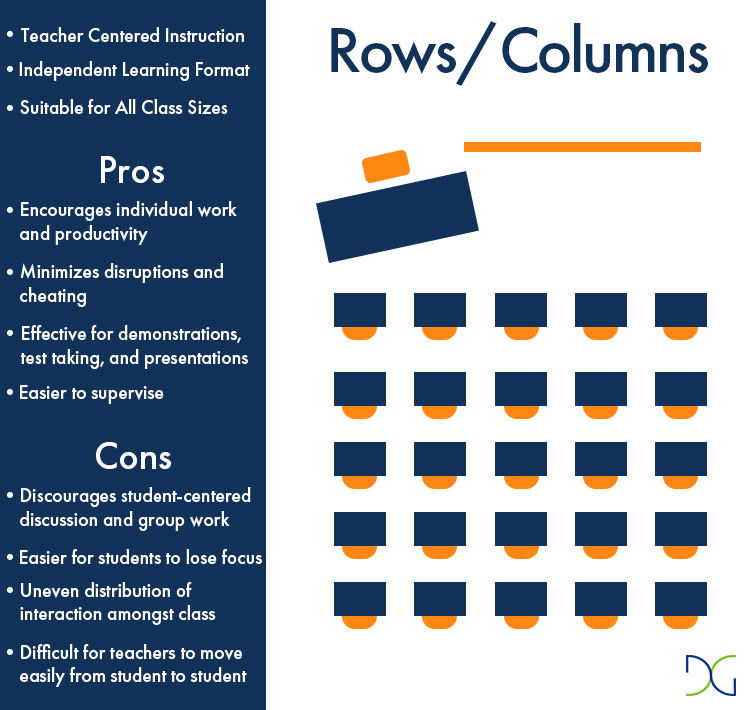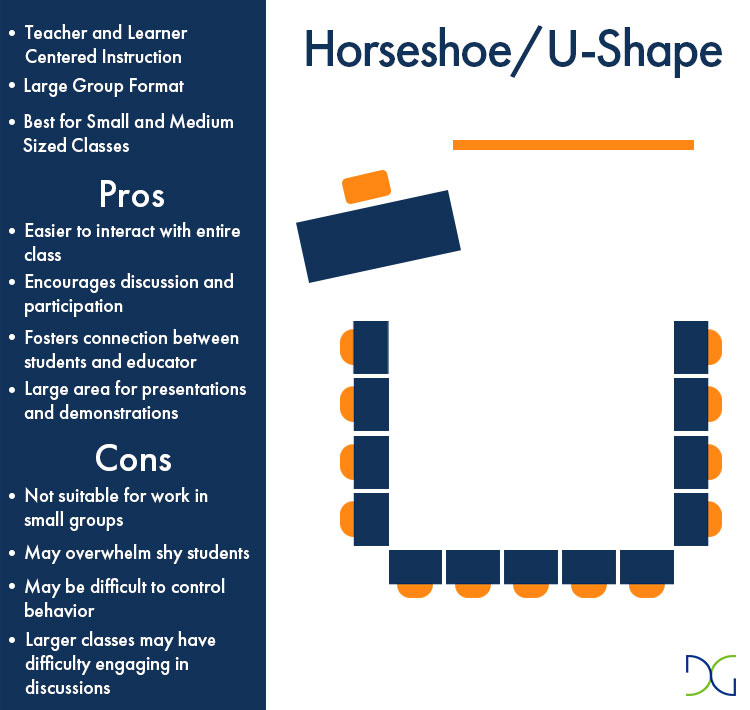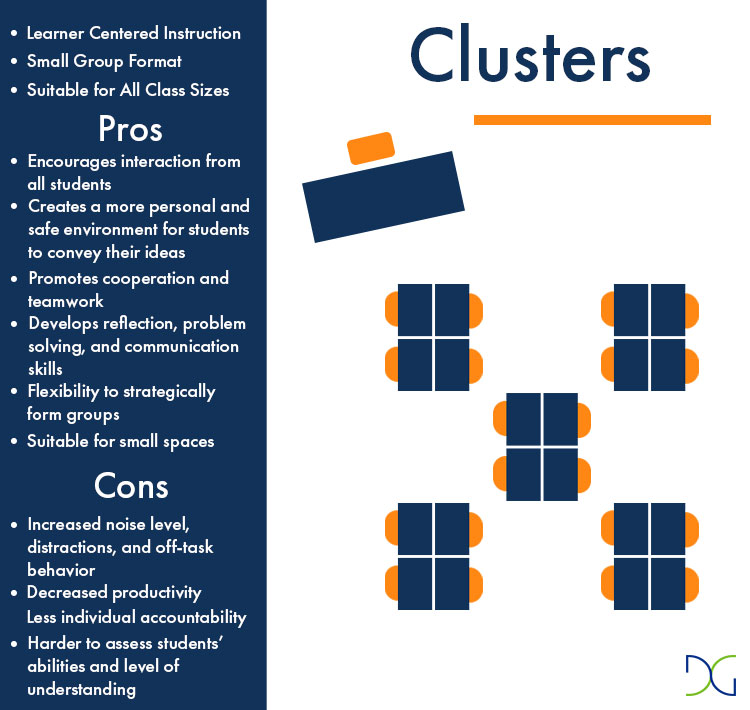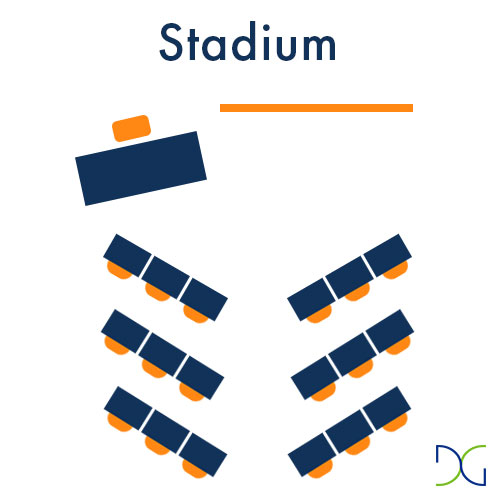
Posted on 12, May, 2015
Last Modified on 28, February, 2023
Shop Products from This Article
Your classroom seating arrangement is just as important as your syllabus. Here are some tips on finding the perfect desk configuration that fits your teaching style, your students, and your classroom space.
You’ve spent countless hours creating the perfect curriculum. You’ve searched the deepest corners of the internet to find creative lesson plans. You’ve stayed after school to give students extra help more days than not. Don’t squander all your hard work by not using an effective classroom seating arrangement.
When your classroom setup is in harmony with your teaching style, your students, and the space and furniture you have to work with, the benefits can be endless. But, when it’s not, it can be detrimental.
Many factors contribute to determining the most effective classroom seating arrangement. With some of these factors changing daily (and sometimes even hourly), it’s important to have a configuration that can be flexible to accommodate classroom variety.
Factors That Influence Classroom Configurations
Classroom Size and Shape
Before you start moving your desks all around, make sure your preferred seating arrangement can work within the space and school furniture you have. Some configurations may not be feasible with certain classrooms. Also, be mindful of obstructions like support beams, poles, walls and other fixtures that can’t be moved. For many teachers, the chalkboard or whiteboard is a major focus in their teaching. Make sure your students can clearly see it without too much strain or difficulty. For more mobility and flexibility, consider swapping your wall-mounted chalkboard for a rolling whiteboard or TV cart or stand with wheels that can be easily moved around the classroom.
Distractions
Identifying and mitigating possible distractions will help streamline your lessons and boost classroom productivity. Things like windows overlooking the playground, nearby busy lobbies and hallways, water fountains or even someone using the pencil sharpener can easily grab the attention of a borderline disengaged student. Try to keep these distractions out of your students’ line of sight.
Student Age and Size
The number of students in your class cannot be discounted when considering classroom seating arrangements. However, just because you have a larger class of 20 or more students doesn’t mean you have to abandon your preferred desk configuration. There is a bevy of variations of each design idea to accommodate most class sizes: you just have to be creative.
The age and maturity level of your students can also hinder your choice selection. When selecting a classroom setup, be aware of what would be age appropriate for your class. If you have students who display behavior issues, be mindful of special seating considerations.
Teaching Style & Objectives
This is the most important factor and, unlike the others we’ve listed, it’s completely in your hands. Classroom seating arrangements support your teaching style and objectives or sabotage them.
Who do you want to be the focus of the class?
- Teacher-Centered Class: If your class is going to be lecture- and presentation-centric, use a configuration where all students can see you and the lectern.
- Learner-Centered Class:With these classes, student discussion and group work are paramount. Find a seating arrangement that encourages students to interact with one another.
- Both: Many educators adhere to the belief that a balanced education has a healthy mixture of both teacher-centered presentations and student-based discussions and work. Look for seating layouts that are flexible and functional.
- Minimal: Interaction flows from the teacher to the student. Student-to-student discussion is scarce. Testing and individual work also dominate the class.
- Small Groups: Students interact in pairs or small groups.
- Large Groups: Students engage in group discussions and lessons with the entire class.
- Knowledge: Students will learn and understand the content of the coursework. Use configurations that support independent activity and emphasize focus on content.
- Skill Growth: Students develop a certain set of skills during this course. For skills that rely on cooperation, communication, teamwork, reflection, etc., layouts that encourage group work and discussion are preferred. For more independent skills like troubleshooting, analysis, listening, etc., look for configurations that support independent work and minimize distractions.
Most Common Configurations
*Note: Traditional layouts shown below. These configurations are still representative of effective layouts, but may be altered for social distancing by ensuring the proper 6ft of space between desks.

Traditional Rows or Columns
The rows configuration (also known as the columns configuration) is the most common classroom arrangement. This type of setup complements class structures that revolve around teacher-based instruction and presentations. Students are more focused on coursework and independent assignments. They are also less likely and/or able to cheat with this layout. Though this seating arrangement can be used with any class size, large classes may often see uneven levels of interaction as students in the front row will participate more while those in the back may lose focus.

Horseshoe or U-Shape
This model supports both student-to-student interaction and teacher-to-student interaction. The class interacts in a large group format, though teachers have ample opportunity to work with students one on one. Courses that emphasize discussions and presentations typically function well with this configuration.

Clusters
Clustering the desks into small groups promotes student-to-student interaction. Students develop skills such as communication, problem solving, collaboration, and more in this arrangement. These clusters offer safe and comfortable environments for students to share ideas. This comfort, however, also lends itself to off-task behavior and large increase in noise level and distractions.
Alternative Configurations
For some educators, the most common classroom seating arrangements aren’t the most effective. There are infinite amounts of variations of clusters, horseshoes, and rows, and even more classroom setups that are completely new and different. Here is just a handful of examples of more alternative approaches.

Runway
Best used with smaller classes, this setup puts the emphasis on the educator. The teacher uses the runway between the two rows of facing desks to conduct the lessons. This layout is great for discussions and lecture based classes.

Stadium
A variation of the classic row configuration and runway, desks are grouped in clusters but all facing the same direction. Like runway, this layout is best suited teacher-centric classes.

Combination
This configuration is great for classes with students of varying learning levels, methods of learning, and behavioral issues. Mix and match any configuration to best fit your needs and your students’ abilities. For example, set up part of the room as rows for students who need to focus on individual work and another part as a mini horseshoe for students who require more discussion-based activities.
Conclusion
Every classroom, teacher, student, and situation is unique. To find the best classroom seating arrangement for you, a little ingenuity and creativity may be necessary. Think outside the box, rows, and horseshoes and create your own configuration. There are plenty of online tools such as Scholastics Class Set-Up Tool and Kaplans Floorplanner to help you develop your own classroom desk layout.
Which classroom layout is right for you?
Take the Quiz!


